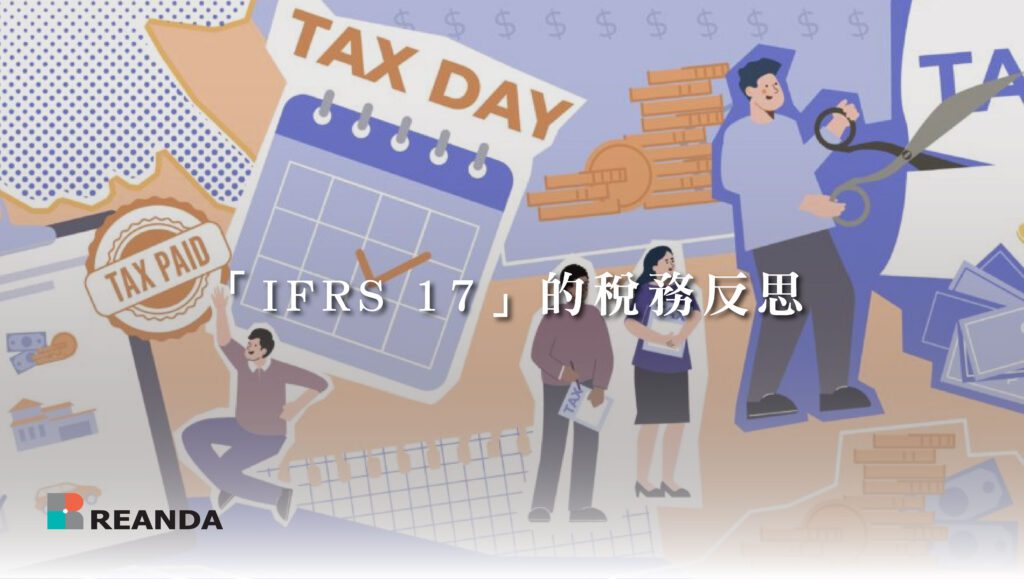「IFRS 17」的稅務反思

「IFRS 17」的稅務反思 作者: 蔡哲明 國際財務報導準則(International Financial Reporting Standards, IFRS)提出IFRS 17「保險合約」,藉此規範保險合約衡量及表達之會計處理準則,以此界定國際之間能有一套會計標準,免除各國逕自建立截然不同施行法則,讓使用者對保險業的財務狀況及經營成效一目了然。 保險合約依照現行會計處理是採類似現金基礎形式處理,使其財務報導別於其他產業,而以長期業務特性(包含盈虧)無法有效控管,負債管理風險(胃納定義)難以全面落實,已經造成保險產業無法健全發展。 利安達平和聯合會計師事務所吳明儀會計師認為IFRS 17準則引領「會計制度」與「清償制度」邁向標準,而金管會要求保發中心統整研擬現行稅賦相關規定,預計年底之前提出具體建議,降低財政部門賦稅影響層面,但可先從營所稅、營業稅、印花稅切入探討。 壹. 營所稅 營所稅可減輕公司「帳務核銷」及「稅務申請」的作業流程,唯有將財務會計與稅務處理相互對照且一致規劃, IFRS 17適用開帳調整數字以及課徵營利事業所得稅及未分配盈餘的影響,賦稅署也將要求金管會及企業主通盤了解,以精簡企業稅務帳務規劃為出發點作為因應。 貳. 營業稅 營業稅以銷售額認定為計稅基礎,現行是以保費收入減除相關責任準備金後計算(制度偏向現金計量),IFRS 17適用後使保單收入認列方式將與以往大相逕庭,賦稅署將責成金管會研擬修法,以確立保費金額的計稅基礎。 參. 印花稅 印花稅是採憑證為課徵範圍及計稅基礎,目前保費需繳納之印花稅是以保險業者保費收據當作依據,IFRS 17適用後目前雖稽徵作業並不影響,但若記帳相關憑證有變,也須連帶調整印花稅的計算方式。 金管會也針對IFRS 17提出四大因應,第一、金管會要求保發中心籌組專案平台,協助業者解決接軌問題;第二、保險業者必須完成精算、計算引擎及總帳等系統需求盤點;第三、金管研擬修正「保險業各種準備金提存辦法」及「保險業財務報告編製準則」在年底之前完成法制程序與相關法規;第四、金管會持續參與國際保險監理官協會之會議,參考其他國家金融政策作為他山之石。 吳明儀會計師提醒現行IFRS 4進化至IFRS 17準則,以會計標準下對保險負債計算產生巨變,例如負債衡量模式有所不同,保險公司收取保費認列收入(含提存法定準備金),但IFRS 17下所收取之保費,認列為保險合約負債,未來保險收入認列會取決於衡量模型的收入釋放方式。臺灣預計2026年實施IFRS 17,保費收入不再直接認列營業收入,會以精算假設所認列的最佳估計負債、非財務風險調整及合約服務邊際攤銷釋放,不僅對於政府課稅機關計稅產生嚴厲挑戰,對企業財務單位節稅也衍生出潛在風險。 2023/05/24
Summary of deductible items for Value-Added Tax (VAT)

Summary of deductible items for Value-Added Tax (VAT) March 30, 2023 Value-added tax (VAT) itself is a consumption tax, so not all documents or invoices can be used to offset VAT. There are several requirements for offsetting input tax: 1. Legitimate certificates issued by the counterparty’s company. 2. The presence of VAT amount. 3. Unified registration number of the company or business entity. It can be seen that the document itself must be an “invoice.” Receipts, service fees, and similar documents that do not have VAT cannot be offset. At the same time, it must occur domestically. Overseas expenses, foreign airline tickets, and commercial invoices issued by foreign companies cannot be offset as they do not pay VAT to the Taiwanese government. Additionally, since VAT is essentially a consumption tax, items that fall under the nature of consumption tax also cannot be offset. However, even if input tax cannot be offset, since these expenses are company costs, they must still be recorded. This way, the actual profit or loss can be determined at the end of the year. The following list includes deductible and non-deductible items for VAT: I. Deductible Items for VAT 1. Purchases: Unified invoices related to the company’s main business activities. 2. Rental expenses: If the certificate is a unified invoice and the lease is signed in the company’s name, the input tax amount can be offset. 3. Stationery supplies. 4. Miscellaneous purchases: Office appliances, computers, air conditioners, telephones, etc. 5. Miscellaneous expenses: Office cleaning supplies, spare parts, etc. 6. Unified invoices for the purchase of real estate, factories, and equipment. 7. Employee uniforms, work shoes, and items provided for use at business premises. 8. Travel expenses: Domestic air tickets, high-speed rail tickets, bus tickets; accommodation expenses, require invoices with unified registration numbers, along with travel expenses. However, accommodation expenses for employee trips that fall under employee benefits cannot be offset against input tax. 9. Freight expenses: Input invoices from courier and freight companies must be obtained. 10. Postage and telecommunication fees: Input invoices for company usage of telephones, telegrams, internet fees, etc. 11. Repair expenses: Maintenance of company vehicles, office equipment, buildings, etc., requires input invoices for offsetting. 12. Advertising expenses: Newspapers, magazines, flyers, posters, samples, TV and internet advertisements related to company operations. As long as input invoices are obtained, input tax can be offset. 13. Water, electricity, and gas expenses: Water and electricity bills and gas fees with the company’s name and unified registration number. 14. Research and development expenses: Expenses incurred for researching new products, improving production technology, etc. 15. Training expenses: Expenses incurred for employee training related to company operations. 16. Fuel expenses: Vehicle fuel and fuel oil costs. 17. Service fees: Input invoices with unified registration numbers, such as fees for consulting companies, translation fees. 18. Miscellaneous purchases: Office appliances, computers, air conditioners, telephones, etc. 19. Miscellaneous expenses: Office cleaning supplies, spare parts, etc. 20. Unified invoices for the purchase of real estate, factories, and equipment. 21. Employee uniforms, work shoes, and items provided for use at business premises. II. Non-deductible Items 1. Salary expenses: Various remuneration paid to employees, such as salaries, bonuses, allowances, overtime pay, etc. Input tax cannot be offset against these expenses. 2. Personal dining expenses. 3. General clothing, handbags, etc. 4. Entertainment expenses for entertaining clients, including travel expenses and accommodation expenses. 5. Gifts given to others for social entertainment or gifts presented to shareholders at shareholder meetings. 6. Personal use of small vehicles. (1) Employee welfare-related expenses. (2) Donated items. (3) Rental expenses for transporting employees to and from work, where the input tax on the rental cannot be offset against the output tax.
Application of Enterprise Accounting Standards for Small and Medium-sized Enterprises for the First Time

Application of Enterprise Accounting Standards for Small and Medium-sized Enterprises for the First Time 30 March 2023 Starting from the year 2016 (105th year in the Republic of China calendar), the financial statements of small and medium-sized enterprises are prepared in accordance with the Enterprise Accounting Standards (EAS) instead of the original ROC GAAP (Generally Accepted Accounting Principles). The EAS is primarily influenced by IFRS (International Financial Reporting Standards) and the IFRS for Small and Medium-sized Entities, taking into account the simplified version of IFRS developed for our country’s corporate practices. 1. Differences between EAS and ROC GAAP The main differences lie in changes to the formats of the four major financial statements and adjustments to accounting items. In the balance sheet, assets and liabilities are classified into current and non-current categories. The income statement is renamed as the comprehensive income statement, divided into current income and other comprehensive income. Other comprehensive income includes items that were previously directly recognized in shareholders’ equity and are now presented in the comprehensive income, helping users of the financial statements understand the performance of management, unrelated to the current income, and hence not affecting the calculation of earnings per share. Additionally, the statement of changes in equity is renamed as the statement of changes in equity, and the cash flow statement separately presents interest, dividends received and paid, and income taxes paid. Other common differences include: Excluding term deposits exceeding three months from cash and cash equivalents. Recognition of benefits from bargain purchases. Inclusion of dismantling, removal, and restoration costs in the cost of property, plant, and equipment. Prohibition of revenue recognition for construction companies using the percentage-of-completion method. Treatment of incentive points and similar items as integral components of sales transactions. Addition of investment properties and biological assets as separate items. Amortization of goodwill and indefinite-life intangible assets or annual impairment testing. 2. Transition Treatment for Initial Application According to EAS 2.22, when transitioning from ROC GAAP to EAS reporting for the first time, two methods are available: the retrospective adjustment method and the non-retrospective adjustment method. 1. Retrospective Adjustment Method According to the first part of EAS 2.22, when companies first apply EAS, they should make retrospective adjustments in accordance with EAS provisions. This is done to determine the initial amounts of assets, liabilities, and equity as of the beginning of the reporting period for the first-time application. For example, – The first-time application in 2016 (105th year), if a retrospective adjustment is made, the assets, liabilities, and equity at the beginning of the year 2016 should be adjusted according to EAS. The difference in assets and liabilities that are adjusted should be directly recognized in the retained earnings or other equity items as of the beginning of the year 2016. – It’s important to note that retrospective adjustment does not involve restating amounts compared to the financial statements of December 31, 2015. However, reclassification is an exception; for instance, deferred income tax assets and liabilities should be reclassified as non-current assets and liabilities in the balance sheet for the comparative period in 2015 as per EAS, although the amounts remain consistent with ROC GAAP. The retrospective adjustment method cannot be used as impractical, except for the following two exceptions: – Capital surplus: Treatment as required by laws and regulations, no adjustment, or elimination of capital surplus to retained earnings. – Functional currency change: The adoption of the new functional currency for the initial date of application. 2. Non-Retrospective Adjustment Method According to the second part of EAS 2.22, when companies first apply EAS on January 1, 2016, they have the option to choose the non-retrospective adjustment method, for example, for financial instruments that already existed, as per the six exceptions outlined. However, based on Letter No. 10800614920 from the Ministry of Finance, for first-time application of EAS after January 1, 2017 (106th year onwards), the retrospective adjustment method should be applied, and the non-retrospective adjustment method cannot be used. 3. Tax Effects of Initial Application According to the Directive No. 10800614920 of the Ministry of Finance, starting from the year 2018 (107th year in the Republic of China calendar), the changes in the initial retained earnings due to the adoption of the new accounting standards should be included in the calculation of corporate income tax.”

